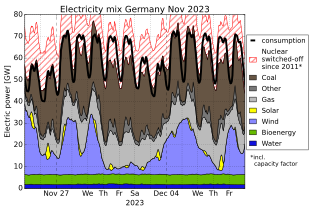Dunkelflaute

In the renewable energy sector, a dunkelflaute (German: [ˈdʊŋkəlˌflaʊtə] ⓘ, lit. 'dark doldrums' or 'dark wind lull', plural dunkelflauten)[1] is a period of time in which little or no energy can be generated with wind and solar power, because there is neither wind nor sunlight.[2][3][4] In meteorology, this is known as anticyclonic gloom.[5]
Meteorology[edit]
Unlike a typical anticyclone, dunkelflauten are associated not with clear skies, but with very dense cloud cover (0.7–0.9), consisting of stratus, stratocumulus, and fog.[6] As of 2022[update] there is no agreed quantitative definition of dunkelflaute.[7] Li et al. define it as wind and solar both below 20% of capacity during a particular 60-minute period.[8] High albedo of low-level stratocumulus clouds in particular – sometimes the cloud base height is just 400 meters – can reduce solar irradiation by half.[6]
In the north of Europe, dunkelflauten originate from a static high-pressure system that causes an extremely weak wind combined with overcast weather with stratus or stratocumulus clouds.[9] There are 2–10 dunkelflaute events per year.[10] Most of these events occur from October to February; typically 50 to 150 hours per year, a single event usually lasts up to 24 hours.[11]
In Japan, on the other hand, dunkelflauten are seen in summer and winter. The former is caused by stationary fronts in early summer and autumn rainy seasons (called Baiu and Akisame, respectively),[12] while the latter is caused by arrivals of south-coast cyclones.[13]
Renewable energy effects[edit]
These periods are a big issue in energy infrastructure if a significant amount of electricity is generated by solar and wind power.[14][1][15] Dunkelflauten can occur simultaneously over a very large region, but are less correlated between geographically distant regions, so multi-national power grid schemes can be helpful.[16] Events that last more than two days over most of Europe happen about every five years.[17] To ensure power during such periods flexible energy sources may be used, energy may be imported, and demand may be adjusted.[18][19]
For alternative energy sources, countries use fossil fuels (coal, oil and natural gas), hydroelectricity or nuclear power and, less often, energy storage to prevent power outages.[20][21][8][22] Long-term solutions include designing electricity markets to incentivise clean flexible power.[19] A group of countries is following on from Mission Innovation to work together to solve the problem in a clean, low-carbon way by 2030, including looking into carbon capture and storage and the hydrogen economy as possible parts of the solution.[23]
See also[edit]
References[edit]
- ^ a b "When the wind goes, gas fills in the gap | Q1 2021 Quarterly Report". Electric Insights. 24 May 2021. Retrieved 29 June 2021.
- ^ "Dark doldrums: When wind and sun take a break". en-former.com. 31 July 2018. Retrieved 27 May 2021.
- ^ Matsuo, Yuhji; Endo, Seiya; Nagatomi, Yu; Shibata, Yoshiaki; Komiyama, Ryoichi; Fujii, Yasumasa (1 June 2020). "Investigating the economics of the power sector under high penetration of variable renewable energies". Applied Energy. 267: 113956. doi:10.1016/j.apenergy.2019.113956. ISSN 0306-2619. S2CID 216301290.
- ^ Ohba, Masamichi; Kanno, Yuki; Nohara, Daisuke (8 December 2021). "Climatology of dark doldrums in Japan". Renewable and Sustainable Energy Reviews. 155: 111927. doi:10.1016/j.rser.2021.111927. S2CID 245067748.
- ^ Li et al. 2021, p. 2.
- ^ a b Li et al. 2021, p. 7.
- ^ "Was ist die Dunkelflaute? | Definition" [What are the Dark Doldrums?]. next-kraftwerke.de (in German). Retrieved 13 December 2022.
- ^ a b Li, Bowen; Basu, Sukanta; Watson, Simon J.; Russchenberg, Herman W. J. (2020). "Mesoscale modeling of a "Dunkelflaute" event". Wind Energy. 24 (1): 5–23. doi:10.1002/we.2554. ISSN 1095-4244.
- ^ Li et al. 2021, p. 6.
- ^ Li et al. 2021, p. 11.
- ^ Li et al. 2021, p. 1.
- ^ Ohba, Masamichi; Kanno, Yuki; Nohara, Daisuke (8 December 2021). "Climatology of dark doldrums in Japan". Renewable and Sustainable Energy Reviews. 155: 111927. doi:10.1016/j.rser.2021.111927. S2CID 245067748.
- ^ Ohba, Masamichi; Kanno, Yuki; Shigeru, Bando (21 January 2023). "Effects of meteorological and climatological factors on extremely high residual load and possible future changes". Renewable and Sustainable Energy Reviews. 175: 113188. doi:10.1016/j.rser.2023.113188.
- ^ Walker, Tamsin (8 February 2017). "What happens with German renewables in the dead of winter?". Deutsche Welle. Archived from the original on 9 February 2017. Retrieved 28 May 2021.
- ^ Ohba, Masamichi; Kanno, Yuki; Shigeru, Bando (21 January 2023). "Effects of meteorological and climatological factors on extremely high residual load and possible future changes". Renewable and Sustainable Energy Reviews. 175: 113188. doi:10.1016/j.rser.2023.113188.
- ^ Li et al. 2021, p. 9.
- ^ McDonnell, Tim (13 December 2022). "Can Europe survive the dreaded dunkelflaute?". Quartz. Retrieved 1 February 2023.
- ^ Modelling 2050: Electricity System Analysis (PDF) (Report). Department for Business, Energy and Industrial Strategy. December 2020. Retrieved 12 December 2023.
- ^ a b "The dreaded Dunkelflaute is no reason to slow UK's energy push". Financial Times. 13 December 2022. Retrieved 13 December 2022.
- ^ Kosowski, Kai; Diercks, Frank (2021). "Quo Vadis, Grid Stability?" (PDF). Atw. 66 (2): 16–26. ISSN 1431-5254.
- ^ Ernst, Damien. "Big infrastructures for fighting climate change" (PDF). Université de Liège.
- ^ Abbott, Malcolm; Cohen, Bruce (2020). "Issues associated with the possible contribution of battery energy storage in ensuring a stable electricity system". The Electricity Journal. 33 (6): 106771. doi:10.1016/j.tej.2020.106771. ISSN 1040-6190. S2CID 218966955.
- ^ Harrabin, Roger (2 June 2021). "Major project aims to clear clean energy hurdle". BBC News. Retrieved 3 June 2021.
Sources[edit]
- Li, Bowen; Basu, Sukanta; Watson, Simon J.; Russchenberg, Herman W. J. (11 October 2021). "A Brief Climatology of Dunkelflaute Events over and Surrounding the North and Baltic Sea Areas" (PDF). Energies. 14 (20): 6508. doi:10.3390/en14206508. eISSN 1996-1073.
